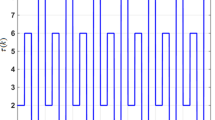Abstract
This paper considers the near-optimal tracking control problem for discrete-time systems with delayed input. Using a variable transformation, the system with delayed input is transformed into a non-delayed system, and the quadratic performance index of the optimal tracking control is transformed into a relevant format. The optimal tracking control law is constructed by the solution of a Riccati matrix equation and a Stein matrix equation. A reduced-order observer is constructed to solve the physically realizable problem of the feedforward compensator and a near-optimal tracking control is obtained. Simulation results demonstrate the effectiveness of the optimal tracking control law.
Similar content being viewed by others
References
R. Sharma and A. Tewari, “Optimal nonlinear tracking of spacecraft attitude maneuvers,” IEEE Trans. on Control Systems Technology, vol. 12, no. 5, pp. 677–682, 2004.
S. S. Mulgund and R. F. Stengel, “Optimal nonlinear estimation for aircraft flight control in wind shear,” Automatica, vol. 32, no. 1, pp. 3–13, 1996.
S. Di Gennaro, “Output attitude tracking for flexible spacecraft,” Automatica, vol. 38, no. 10, pp. 1719–1726, 2002.
S. K. Ider, “Force and motion trajectory tracking control of flexible joint robots,” Mechanism and Machine Theory, vol. 35, no. 3, pp. 363–378, 2000.
M. Mauder, “Robust tracking control of nonholonomic dynamic systems with application to the bisteerable mobile robot,” Automatica, vol. 44, no. 10, pp. 2588–2592, 2008.
M. T. Grabbe and D. M. Dawson, “Application of optimal control theory to the trajectory tracking of rigid robot manipulators,” Optimal Control Applications and Methods, vol. 15, no. 4, pp. 237–249, 1994.
B. Jayawardhana and G. Weiss, “Tracking and disturbance rejection for fully actuated mechanical systems,” Automatica, vol. 44, no. 11, pp. 2863–2868, 2008.
H. Lian, E. Feng, X. Li, J. Ye, and Z. Xiu, “Oscillatory behavior in microbial continuous culture with discrete time delay,” Nonlinear Analysis: Real World Applications, vol. 10, no. 5, pp. 2749–2757, 2009.
X. Fan, M. Arcak, and J. T. Wen, “Robustness of network flow control against disturbances and timedelay,” Systems and Control Letters, vol. 53, no. 1, pp. 13–29, 2004.
S. Gumussoy and H. Ozbay, “Sensitivity minimization by strongly stabilizing controllers for a class of unstable time-delay systems,” IEEE Trans. on Automatic Control, vol. 54, no. 3, pp. 590–595, 2009.
A. Haidar and E. K. Boukas, “Exponential stability of singular systems with multiple time-varying delays,” Automatica, vol. 45, no. 2, pp. 539–545, 2009.
M. Jankovic, “Control Lyapunov-Razumikhin functions and robust stabilization of time delay systems,” IEEE Trans. on Automatic Control, vol. 46, pp. 1048–1060, 2001.
N. Luo, M. De La Sen, and J. Rodellar, “Robust stabilization of a class of uncertain time delay systems in sliding mode,” International Journal of Robust and Nonlinear Control, vol. 7, pp. 59–74, 1997.
C.-C. Hua, Q.-G. Wang, and X.-P. Guan, “Adaptive tracking controller design of nonlinear systems with time delays and unknown dead-zone input,” IEEE Trans. on Automatic Control, vol. 53, no. 7, pp. 153–1759, 2008.
M. Basin and J. Rodiguez-Gonzalez, “A closed-form optimal control for linear systems with equal state and input delays,” Automatica, vol. 41, no. 5, pp. 915–920, 2005.
B. Michael and R.-G. Jesus, “Optimal control for linear systems with multiple time delays in control input,” IEEE Trans. on Automatic Control, vol. 51, no. 1, pp. 91–97, 2006.
B. Michael and P. Joel, “An optimal regulator for linear systems with multiple state and input delays,” Optimal Control Applications and Methods, vol. 28, no. 1, pp. 45–57, 2007.
G. Cai and J. Huang, “Optimal control method with time delay in control,” Journal of Sound and Vibration, vol. 251, pp. 383–394, 2002.
H. S. Zhang, G. R. Duan, and L. H. Xie, “Linear quadratic regulation for linear time-varying systems with multiple input delays,” Automatica, vol. 42, no. 9, pp. 1465–1476, 2006.
H.-H. Wang and G.-Y. Tang, “Observer-based optimal output tracking for discrete-time Systems with multiple state and input delays,” International Journal of Control, Automation and Systems, vol. 7, no. 1, pp. 57–66, 2009.
Author information
Authors and Affiliations
Corresponding author
Additional information
Recommended by Editorial Board member Shengyuan Xu under the direction of Editor Young Il lee. This work was supported by the National Natural Science Foundation of China (Grants No. 40776051, 40806040) and the Key Natural Science Foundation of Shandong Province (Grant No. Z2005G01).
Shi-Yuan Han received his M.S. degree from the College of Information Science and Engineering, Ocean University of China. Since September 2009, he has been pursuing his Ph.D. degree at the same university. His main research interests include analysis and control for time-delay systems and networked control systems.
Gong-You Tang received his Ph.D. degree in Control Theory and Applications from the South China University of Technology, P. R. China in 1991. He is a Professor at the College of Information Science and Engineering at the Ocean University of China, Qingdao, P. R. China. He is the Editor of the Journal of the Ocean University of China and Control and the Instruments in Chemical Industry. His research interests are in the areas of nonlinear systems, delay systems, large-scale systems, and networked control systems, with emphasis in optimal control, robust control, fault diagnosis and stability analysis.
Cheng-Ming Zhang received his M.S. degree from the College of Information Science and Engineering, Ocean University of China. Since September 2008, he has been pursuing his Ph.D. degree at the same university. His main research interests include computer control, analysis and control for nonlinear systems, and optimal control.
Rights and permissions
About this article
Cite this article
Han, SY., Tang, GY. & Zhang, CM. Near-optimal tracking control for discrete-time systems with delayed input. Int. J. Control Autom. Syst. 8, 1330–1335 (2010). https://doi.org/10.1007/s12555-010-0619-4
Received:
Revised:
Accepted:
Published:
Issue Date:
DOI: https://doi.org/10.1007/s12555-010-0619-4



